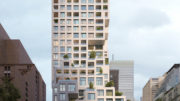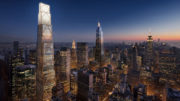As the New York City Landmarks Preservation works to clear the backlog of items on its calendar for consideration since before 2010, it has mostly dealt with buildings, a.k.a. potential individual landmarks. However, there have been some interiors considered, such as the Osborne Apartments lobby. Another such case is the Edgar J. Kaufman Conference Center at 809 United Nations Plaza in Midtown East.
Located on the 12th floor of the Institute of International Education (IIE), the complex under consideration for interior landmark designation includes two conference rooms separated by a folding partition, a 300-person lecture hall, and an elevator lobby. They were constructed between 1964 and 1965 and are the product of Finnish architect Alvar Aalto and his wife, designer Elissa Aalto.
The elevator lobby features cobalt blue tiles. According to the LPC’s own research staff statement from 2002, the lecture hall has “an undulating white plaster ceiling that gently rises toward the east, curving walls paneled to picture-rail height in ash with spaghetti battens continuing to the ceiling.” The cost was underwritten by Edgar Kaufman, Jr., whose family commissioned Frank Lloyd Wright to design Fallingwater. At the time, New York Times architecture critic Ada Louise Huxtable called it the “most beautiful and distinguished interior New York has seen in many years.”
The Kaufman Center is currently available to be rented for functions. The space was previously considered by the commission on November 20, 2001 and September 10, 2002. The building housing it has not been designated an individual landmark.
Kay Murray, Vice President, General Counsel and Secretary for the IIE, testified in opposition to designation, saying they are staying in the space for the foreseeable future. The IIE’s land use attorney, Frank Chaney, disputed the very idea that the space is eligible for landmark designation, saying it wasn’t actually open to the public. Community Board 6’s Mark Thompson also said the space is “not open.”
Meanwhile, Kelly Carroll of the Historic Districts Council praised Alvar Aalto as “the most important Finnish architect of the 20th century and a central figure in International Modernism, famous for his marriage of the naturalism of Finnish Romanticism with modernist ideals.” The complex is Aalto’s only work in New York City and one of only four remaining works in the United States.
Carroll said the space is indeed accessible to the public. “From weddings and cocktail receptions to lectures and alumni events, guests are able to enjoy the Center year-round,” she said. “The IIE invites visitors to the space quite frequently for Fulbright scholarship interviews, and the Finnish Embassy hosts its annual holiday gala there in honor of Aalto, who remains a source of great national pride for the Finns.”
The HDC and other organizations have led an effort to preserve the space. That includes the New York Landmarks Conservancy, whose Andrea Goldman testified.
Architect Laura Heim of the American Institute of Architects (AIA) was married there and called it “exceptional” and “a jewel.” She said some of the guests came only to see the space. Her husband, the City Club’s Jeffrey Kroessler, maintained that the space is “open and rentable.”
John Arbuckle of the AIA’s Historic Buildings Committee endorsed designation, as did Erin Tobin of the Preservation League of New York State. Preservationist Theodore Grunewald called the space a “masterpiece.”
The next move for the LPC will take place next year, when it will consider either prioritizing designation for some items by December, removing items from the calendar by voting not to designate, or removing items from the calendar by issuing a no action letter.
Subscribe to YIMBY’s daily e-mail
Follow YIMBYgram for real-time photo updates
Like YIMBY on Facebook
Follow YIMBY’s Twitter for the latest in YIMBYnews






To be clear: Since 2010, the Kaufmann Conference Rooms were rented to (as stated on the IIE’s web site) “sponsors of IIE programs or activities or to other non-profit organizations when the organization or its proposed use of the space is consistent with IIE’s mission, including promoting closer educational relations between peoples of the United States and other countries and fostering sustainable development.” Since 2010, IIE has rented the space to such non-profit organizations for a total of 81 events – on average, about once per month – all of which were private, by-invitation-only events to which the general public at large was excluded. That does not meet the standard laid out by the New York Court of Appeals in the Four Seasons case that to qualify as an interior landmark under the Landmarks Law’s “customary accessibility” requirement, “the very nature” of a business must be such that the general public at large has an open invitation entailing “usual, ordinary or habitual” (not “rare or infrequent”) access to the interior space. The very nature of the IIE’s business is private, not public – readily distinguishable from the types of businesses and interior spaces the Court of Appeals found to be customarily open to the public: restaurants, theaters and train stations. And the infrequency of the Rooms’ use by outside not-for-profits (for private, invitation-only events) is not usual, ordinary or habitual. Designation of the Kaufmann Conference Rooms would, therefore, be contrary to the law as clearly set forth and explained by the Court of Appeals.
Talk about abuse of the landmarks process.. a CONFERENCE ROOM?! Next you’ll tell me that certain urinals are up for consideration…